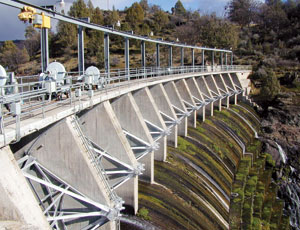The largest dam removal and river restoration project in U.S. history moved a step closer to reality last month as the U.S. Dept. of the Interior, Oregon, California, PacifiCorp and about 40 other groups signed agreements that will set into motion the $200-million removal of four dams on the Klamath River and the $1-billion restoration of the Klamath Basin.
The dams, owned by PacifiCorp, a subsidiary of Warren Buffet’s Mid-American Energy Holdings Inc., Des Moines, Iowa, would continue to produce power until removal begins. The Federal Energy Regulatory Commission estimates their dependable capacity at 43 megawatts.
Sedimentation over time has reduced the concrete and earthern structures’ efficiency. Built between 1918 and 1962, they are operating at less than a third of their designed rated capacity: J.C. Boyle (90 MW), Copco 1 (20 MW), Copco 2 (27 MW) and Iron Gate (18 MW).
The Dept. of the Interior must determine by March 31, 2012, whether removing the dams is in the public interest and if the process would help restore salmon in the Klamath Basin. Work could occur no earlier than 2020, though pre-removal work could start earlier.
The Klamath Basin Restoration Agreement and the Klamath Hydroelectric Settlement Agreement spell out several steps that must occur before the deadline, including further studies on the sediments behind the dams, economic impact of removal and a full National Environmental Policy Act analysis.
By 2012, the Dept. of the Interior will also determine whether a federal agency or a private contractor will oversee removal. Right now, the Bureau of Reclamation is likely to be the designated “dam-removal entity,” according to bureau spokesman Kip White. “The goal originally was to have a non-federal dam entity,” he says. “But there may not be anyone out there [who] may be willing to take on the liability and potential risk.”
A 2009 report by engineering consultant Camp, Dresser & McKee Inc., Cambridge, Mass., identified 130 potential physical, biological and socioeconomic liabilities associated with decommissioning which, as a worse-case scenario, could boost project costs by $675 million.
Removal costs are capped at $450 million and would be paid by PacifiCorp ratepayers and the state of California, according to the agreement. Klamath Basin restoration is expected to cost $1 billion, and the program would be paid for by federal funds that would need Congressional appropriation.
The 2012 report also will determine the method for dam removal and whether any of the sediment behind the dams should be removed before the dams are demolished. Gathard Engineering Consulting, Seattle, Wash., in a 2006 report estimates that there are 8.8 million cubic yards of sediment behind the Iron Gate Dam, the farthest downstream; at least 80% is silt and clay. CDM’s report recommended further study on the sediments behind all four dams to characterize the contaminants.



Post a comment to this article
Report Abusive Comment